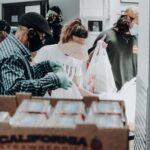
The rise of slow fashion in Ontario
Combating fast fashion with local efforts
A growing number of professionals and hobbyists are working hard to bring clothing and textile manufacturing back to Ontario.
“Clothing has been priced too cheaply for too long, so people don’t really understand how much work goes into things,” says Alexandra Julian, a production manager at a recycled clothing company.
This movement away from fast fashion in favour of local, environmentally-conscious textile manufacturing is slowly gaining popularity as people are becoming more conscious of their environmental impact.
Starting from the soil, ending in the soil
“I like to tell people we’re soil farmers,” says Andrew MacDonald, an Ontario-based homesteader.
MacDonald bases his family homestead around a concept known as regenerative agriculture.
“Basically, what it means is that we build topsoil unlike commercial agriculture, which erodes it,” he says.
This topsoil erosion is a problem in many forms of modern farming. According to the Ontario Ministry of Agriculture, Food and Rural Affairs, topsoil erosion lowers crop yield. It also increases pollution and promotes habitat destruction.
“Sheep are grazers, so we feed them on grass,” MacDonald says. “We could essentially get infinite wool from grass and build soil at the same time.”
Some experts are critical of this view, believing that animal agriculture is bad for the environment.
“I disagree, obviously,” says MacDonald. “It’s an issue with industrial animal agriculture, not all animal agriculture. You can raise animals sustainably.”
In addition to sheep, the MacDonald family has experimented with growing cotton and flax. They have also grown plant material to be used as natural dyes.
“What I think is so special about using natural materials is that when you’re ready to throw them out, you can actually just compost them,” MacDonald says.
Spinning yarn, weaving and sewing
“I take raw wool and make it into fabric,” says Emily Campbell, an Ontario-based weaver and spinner. “It’s an incredibly rewarding process.”
Raw wool is the unwashed, shorn fleece from a sheep.
She explains that she also enjoys working with alpaca fleece, silk and cotton, but often, she works with wool.
This is partly because wool is the most available local fibre, but also because of her preference.
Wool, she explains, is water repellant and antimicrobial. It is also good in hot and cold weather due to its ability to regulate heat. To Campbell, this makes wool the best fibre to use in Ontario.
The process for making a wool textile is involved and laborious. After cleaning the wool, the fibre is sometimes blended with other fibre, then dyed and carded.
“Carding is basically brushing the wool to detangle, separate and straighten the individual fibre,” Campbell explains.
After carding, the wool is spun, then woven into fabric on a loom.
“It takes many days and many steps. It’s a long process,” she says.When the fabric is made, Campbell enjoys using it to make her own clothes.
Recycling clothes and mending
“At my work, we cut up old existing garments, blankets, quilts and make them into new garments”, Julian explains.
According to Julian, there is significant textile waste in Ontario.
“There are entire places called rag houses that have, I mean, incredibly enormous amounts of old clothing,” she says.
These rag houses exist to accept old textile waste to send them overseas. Much of which is destined for a landfill or incinerator.
Julian is not alone in thinking textile waste is a problem. Research from 2022 shows that 73 per cent of garments and textiles are thrown out. Yet, 95 per cent of them could have been recycled.
In addition to recycling, Julian says she practices reducing consumption. One way she does this is by mending.
“It used to be a totally normal chore along with laundry or dishes, but instead, something gets a hole in it, and we throw it out,” she says.
Though Julian advocates for recycling clothing, she is quick to caution that it does not entirely solve the issue.
“It often ends up with people buying already usable garments and cutting them up for their own creative satisfaction,” she explains.
Julian says it is important to save and repurpose damaged textiles instead.
More than recycling, though, Julian advocates for a slow, more conscious attitude towards clothing.
“If you make all of those parts locally and pay fairly, the cost of clothing shoots up so dramatically,” she explains. “We would almost need to return to a time where people owned far, far fewer pieces of clothing and take more of a make-do-and-mend attitude.”
About the author
Eliot is a journalist for Youth Mind. His background is in English and creative writing at York University. When not writing, he studies medical laboratory science in Kingston, and enjoys hand spinning yarn, cooking, and gardening.







